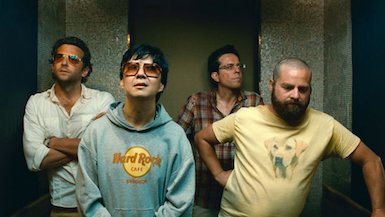The Number One Movie in America: The Hangover Part II
By Sean Collier
March 20, 2020
BoxOfficeProphets.com

Not in terms of box-office success. We’ll get to its surprising profitability in a moment. It’s a disaster, rather, of ill-advised filmmaking.
The first “Hangover,” something of a surprise hit in 2009, leaned on its then-fresh comic talent (notably Zach Galifianakis and Ed Helms) to create a surprising, outlandish blend of caper, broad comedy and mystery.
Its sequel simply did the first plot again — a bad idea, but not an uncommon one with comedy sequels. Where “Part II” really suffers is in tone; the movie is a nihilistic, angry stream of unpleasantness, where jokes are shoved aside in favor of crass happenstance. The scenarios faced by our unlikable heroes aren’t wacky, comedic or even awkward; they’re dispiriting.
This is a movie of bad things happening to relatively bad people, with precious little humor to break up the ugliness.
“The Hangover Part II” is also callously offensive to a laundry list of demographics — I tried to keep a list, but couldn’t keep up — in a way that can’t simply be explained away by saying, “It was a different time.” (It wasn’t that long ago. We still knew what was in poor taste.) Blame, perhaps, director and co-screenwriter Todd Phillips, who has loudly groused about how comedy can no longer push the envelope.
Todd: Sure it can! A good start, however, would be making it funny. Hanging a laugh line on Zach Galifianakis’ abrasive loser calling Neil Patrick Harris “a gay,” for instance, isn’t funny. It’s just a lazy shock line.
At the risk of devolving into a Todd-Phillips-is-bad TED Talk, the shift in tone between the first and second “Hangover” films coincides with the departure of writers Jon Lucas and Scott Moore, who wouldn’t return for a sequel. Lucas and Moore aren’t exactly Mel Brooks, but they seem to have brought a levity to the proceedings that began to vanish when the screenwriting was left primarily in the hands of — let me check my notes, here — Todd Phillips. (He had a pair of co-writers I won’t defame by mentioning.)
Anyway, it was a hit. The original was a sleeper success that pulled in audiences over the course of the summer; two years later, anticipation was high for another chapter. “The Hangover Part II” was released over Memorial Day weekend of 2011, pulling in more than $103 million over the four-day frame. Its $254.4 million domestic total is the fourth-highest mark of the year; “Part II” earned more than such hits as “Fast Five,” “Mission Impossible: Ghost Protocol” and “Cars 2.”
It’s illustrative to me, however, that it still earned less than its predecessor. Even with an opening weekend that more than doubled that of “The Hangover,” the first film outgrossed its sequel by more than $20 million.
The downward trend would continue, as “The Hangover Part III” — somehow, an even worse film — failed to win a weekend and limped to a $112.2 million finish.
Phillips would go on to earn many, many Oscar nominations.
“The Hangover Part II” is the subject of thethe latest episode of The Number One Movie in America, a look back at past box-office champions. Each episode’s film is drawn at random from a list of every number-one movie since the late 1970s. Please listen and subscribe!
Next time: Wizards! Not your favorite wizards, but ... well, they’re sort of adjacent to your favorite wizards.